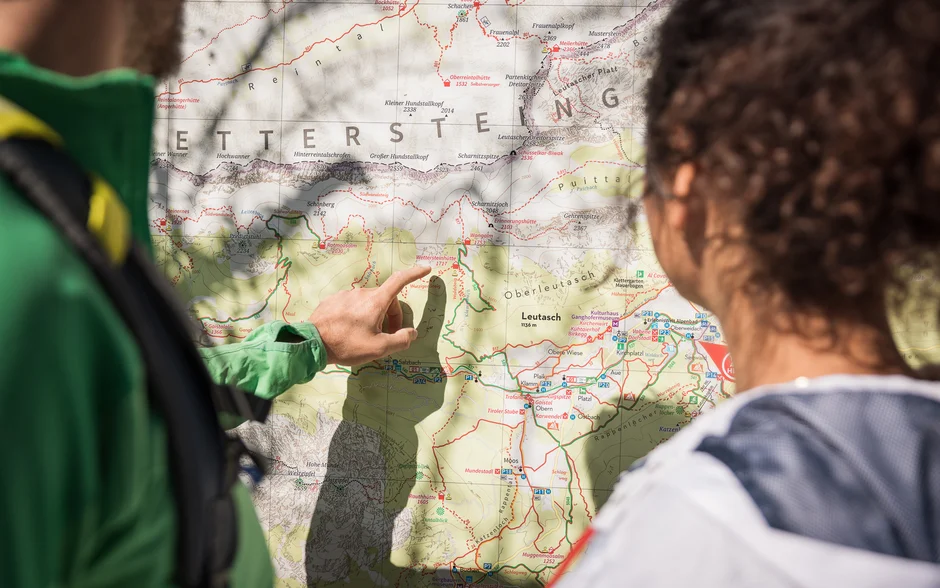5 things you must experience in Leutasch
IMPRESSIVE NATURAL AND CULTURAL TREASURES
With these five tips, you can visit some of the most beautiful natural sites, embark on a journey through time and learn about centuries-old Tyrolean traditions. The BIO Hotel Leutascherhof is the perfect starting point for experiences that will allow you to discover or rediscover one of the most magnificent landscapes in the Alps.
Leutasch and the Karwendel Mountains are rich in nature and history. Formed over millions of years, the majestic mountains have seen it all: medieval shepherds with their herds of cattle, the first settled farmers, noble landlords, raftsmen and, last but not least, hikers and mountain bikers exploring the ancient trails. We present five opportunities to experience Leutasch and the Karwendel in very different ways.
1 / The Gaistal Alpine pasture paradise
The extremely romantic Gaistal valley, which separates the Wetterstein mountains from the Mieminger mountains, stretches from Leutasch towards Ehrwald. The high valley, characterised by alpine pastures, forests and the grey rock of the peaks, is a place of longing for hikers and bikers. Without a car, in hiking boots or on a bike, you can get closer to the uniquely beautiful mountain nature. Deer, stags and chamois live here; the airy, clear heights are home to the golden eagle. Cows, sheep and horses graze on the alpine pastures, and seven of the most beautiful alpine pastures far and wide are worthwhile destinations for scenic hikes. Tip: Pack the novel ‘Das Schweigen im Walde’ (Silence in the Forest) in your hiking rucksack and let the thoughts of the writer Ludwig Ganghofer sink in at a quiet spot.
Read more about the Gaistal valley …
2 / The Gleirschklamm gorge near Scharnitz
Mountains and gorges are inseparable in Tyrol. One of the most beautiful gorges is the Gleirschklamm in the Karwendel. On a narrow path that leads over bridges, rope-secured sections and through rock, you are very close to the wild, clear mountain water. Small waterfalls cut through imposing rock formations and dippers perform daring flight manoeuvres. The path through the Gleirschklamm gorge requires sure-footedness and a head for heights. Tip: Combine the 45-minute hike through the impressive mountain gorge with the circular route via the Isarsteig and the rustic Scharnitzer Alm.
Read more about the Gleirschklamm gorge …
3 / The Großer Ahornboden in the Karwendel
Some call it the most beautiful place in the Karwendel Mountains – the Großer Ahornboden with its ancient sycamore trees and the lively Rissbach stream. Once you arrive at the Eng Alm, you feel like you've landed in the middle of a picture book. From mid-May to mid-September, the alpine village with its low huts made of weather-beaten wood is home to the alpine farmers who herd the cattle grazing here and produce the incomparably aromatic Enger Alm cheese. The grazing cattle ensure that the grass remains short and the typical appearance of the Großer Ahornboden is preserved. Tip: Where the Großer Ahornboden is, the Kleiner Ahornboden is not far away. This is located above the better-known part and is definitely worth an extra hike from the Bavarian side – the steep limestone cliffs of the Karwendel are within reach here.
Read more about the Großer Ahornboden …
4 / The Porta Claudia near Scharnitz
Tips 1 – 3 referred to special natural beauties, while tips 4 and 5 relate to history and tradition. Porta Claudia does not date back to Roman times, as its name suggests. Rather, the defensive structure at the narrow point of the Scharnitz Pass in the Isar Valley was built in the 17th century to defend against the advancing Swedes. The structure is named after Claudia de Medici, Archduchess of Austria and Princess of Tyrol, who wanted to protect the country during the Thirty Years' War. The barrier was so impressive that it was even described by Johann Wolfgang von Goethe during his trip to Italy. What the Swedes failed to achieve was accomplished by Napoleon's troops in 1805, who subsequently advanced to Innsbruck. Today, impressive remains of the wall, up to six metres high, have been preserved from the Porta Claudia. Once an important border wall, the Porta Claudia is now a very romantic place and an insider tip for history enthusiasts. Tip: Take the short cultural hike from Scharnitz to the Porta Claudia!
Read more about the themed hike …
5 / Cattle drive in Leutasch
Even the most beautiful alpine summer inevitably comes to an end at the end of September. On the high alpine pastures, all signs point to winter, and the occasional snow shower can already fall from the sky. For the alpine farmers and their cattle, the time has come to say goodbye, which is always accompanied by a touch of melancholy. Cattle, sheep and the golden-blond Haflinger horses migrate back to their winter stables, where they will spend the cold months safe and warm. If the alpine summer has passed without accidents, there is much celebration. The decorated animals are welcomed in the valley and then there is plenty to eat, drink and talk about. Tip: Take part in the cattle drive in Leutasch, which is still celebrated in a very traditional and authentic way.
Leutasch is a worthwhile holiday destination not only in summer, but also in all other seasons.
Browse the Leutascherhof offers now and choose your dream holiday



